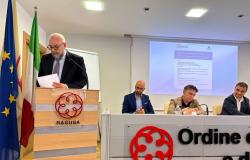The meeting organized by Confesercenti Grosseto in Gavorrano, in collaboration with the Colline Metallifere National Park, was a meeting full of content, represented by the intervention of its director Alessandra Casini, in the desire to enhance the role of territorial network subjects. The conference, entitled: ‘What tourist (and commercial) development for the Colline Metallifere area’, took place in the conference room of the Municipality of Gavorrano, to raise the issue of the economic and social sustainability of the internal areas, to have a moment of reflection open to citizens, businesses and candidates, in this phase of renewal of municipal governments, proposing analyzes and reflections useful to the vast Grosseto hinterland, from the Colline Metallifere to the municipalities of Amiata Grossetana, up to the hills of Albegna.
We want to start from the analysis of the territory carried out by Rossano Pazzagli, professor of History of the territory and the environment at the University of Molise and director of the School of small municipalities for the regeneration of internal areas, who spoke about the dynamics of depopulation and social rarefaction and productive, which began in the era of the industrialization of the country, with the consequent abandonment of the land and the resulting dynamics of hydrogeological instability, the decline of sheep farming and the consequent return of the forest.
However, a rebirth of the internal areas is still possible, enhancing the vocation of the territories, and encouraging the participation of local communities, also creating a new economy and a supply chain that unites countryside and city, coast and hinterland through the strengthening of the institutional network (Municipalities, areas protected, consortia).
Tourism can represent an important resource if it is possible to read the territory, valorising its specificities and its heritage, thus avoiding seeing growth only in quantity, transmitting a stereotyped image of the places, depersonalising the villages by “kicking out” the residents favor of B&B for tourists.
Any economic development for the territory cannot ignore resident human capital, both from a commercial point of view as the structural basis of local demand, and as an employed and autonomous workforce, to structure the local tourist offer.
The current situation of the inland municipalities is clearly that of demographic winter, i.e. continuous decline in the resident population due to the annual negative balance of the difference between births and deaths, in the absence of external emigration, and aging of the resident population, with consequent contraction of the population active. The photography presented by Claudio Saragosa, professor of urban planning at the University of Florence, is punctual on the topic.
The housing situation is obviously uneven: against a population density of 365 inhabitants per square meter that we find in Follonica, in Montieri we find a situation of 11 inhabitants per square meter. Different situations requiring different policies.
For example, providing policies to support small businesses in the hinterland municipalities, through tax relief and non-repayable contributions for the start-up of new production activities, as requested in his speech by the president of Confesercenti Gavorrano Stefano Salvetti. Policies for the activation of widespread services (health shops, community emporiums, etc…) for which even the commercial establishments themselves can be a reference, policies that lead to the growth of tourist flows also through the launch of widespread hospitality projects. The short-term tourist rental system is in fact an opportunity for the municipalities of inland areas, while on the coast it becomes a degenerative phenomenon with often negative consequences. The widespread tourist reception project can truly be the keystone. As underlined by the speech by Giancarlo Dell’Orco, destination manager and president of the Cooperativa Coopera, as well as president for Confesercenti Grosseto of the non-hotel accommodation union.
The idea is to attract “different” tourism, one that is not only linked to the sea, but one that also frequents our areas “out of season”, because it is attracted by the naturalistic and architectural peculiarities of the area. Responsible and sustainable tourism because it is in harmony with the resident communities.
The Confesercenti Grosseto trade association aims for a project proposal of “Widespread Tourist Reception” for the villages of the Maremma hinterland for an experiential tourism with a participatory approach, making use of adequate professionalism and based on three important elements: relationships to increase quality of our hospitality services, the authenticity of local products, supported by human relationships with a strong identity matrix and the participation of the communities which becomes the lifeblood that fuels the love for one’s land and its traditions.
A tourist offer capable of intercepting a demand that appears to be in total mutation, characterized by the search for places where it is possible to maintain distancing, by the safety offered by less crowded locations, by lower costs for shorter holidays and by the preference for places where you perceive a good welcome, authenticity. A tourist demand that is decidedly more oriented towards a national, proximity market, with a maximum travel time of three or four hours and daily hiking activities. As underlined in his speech by Giuseppe Salomi, Area manager central north Italy, Israel ang global account at Booking.com, showing the changes in tourist demand that uses the main global tourist portal.
Confesercenti once again presents itself as a union capable of making proposals as well as protesting, aware of the need for complex project development in order to address equally complex problems that affect local communities starting from the trade and tourism sectors.
Read the other Confesercenti news from the area





